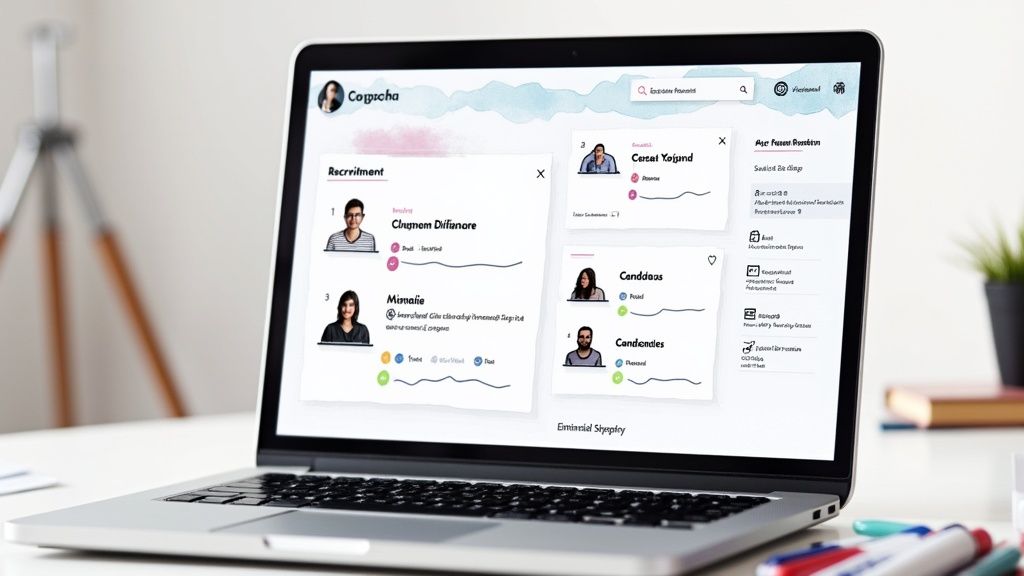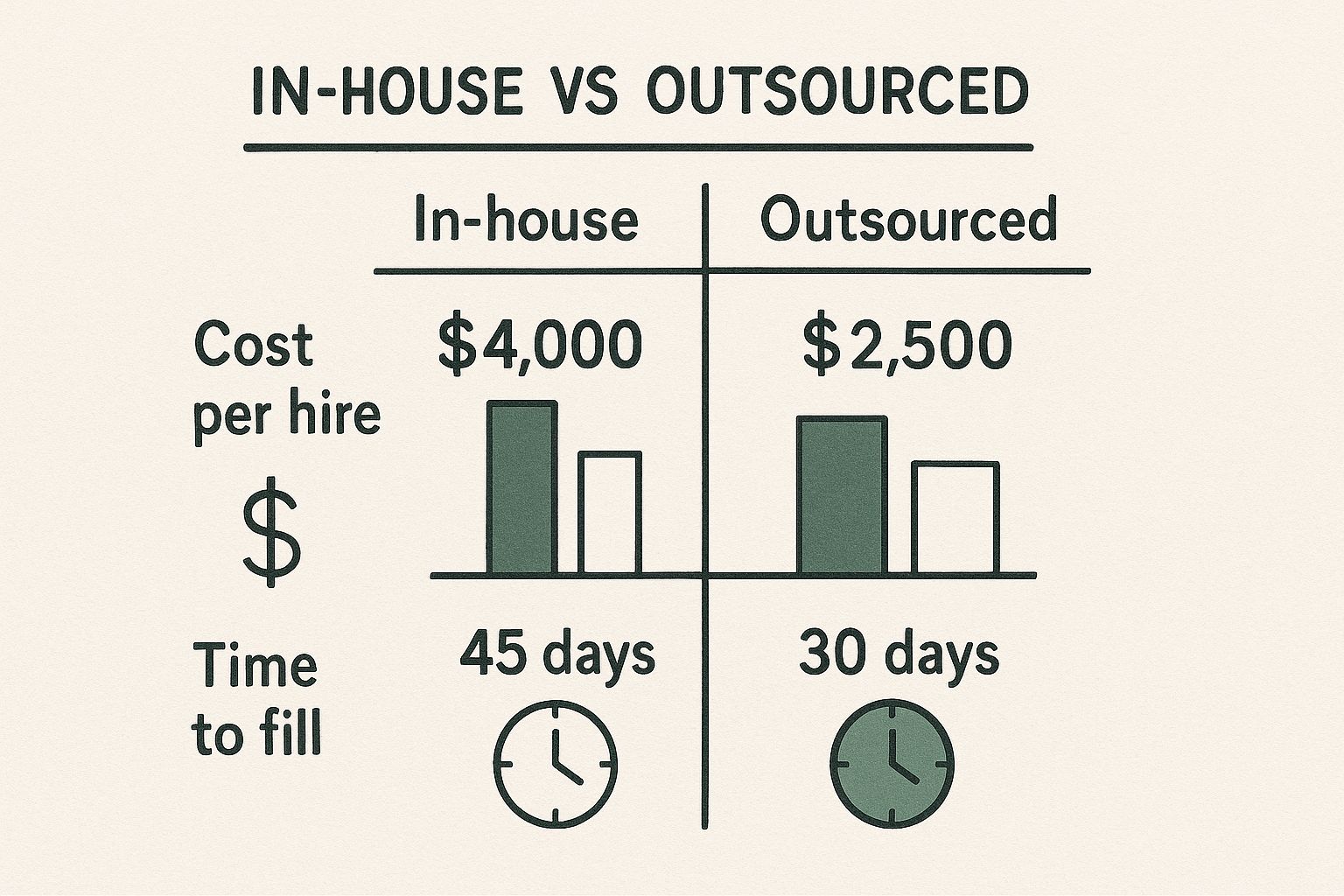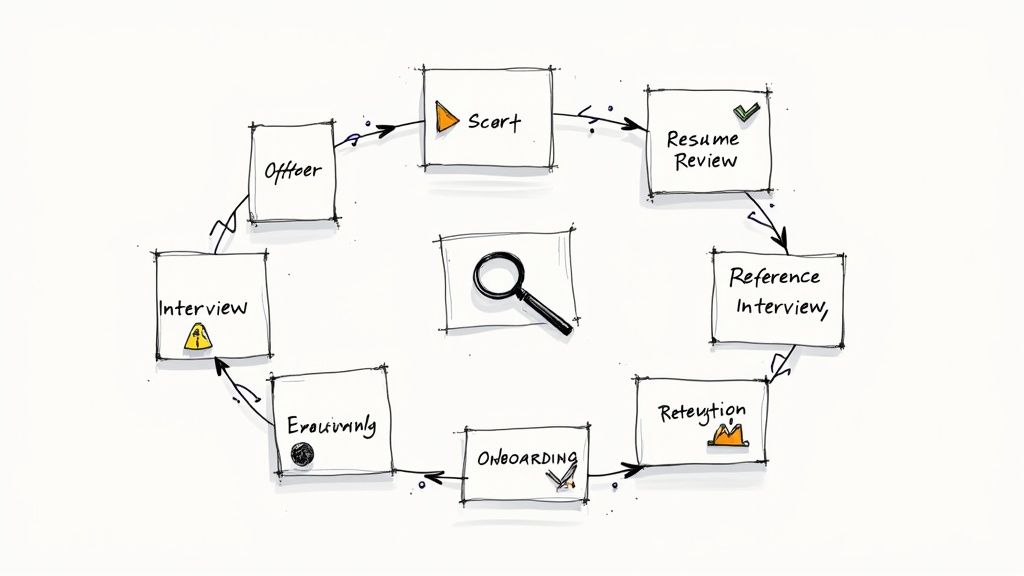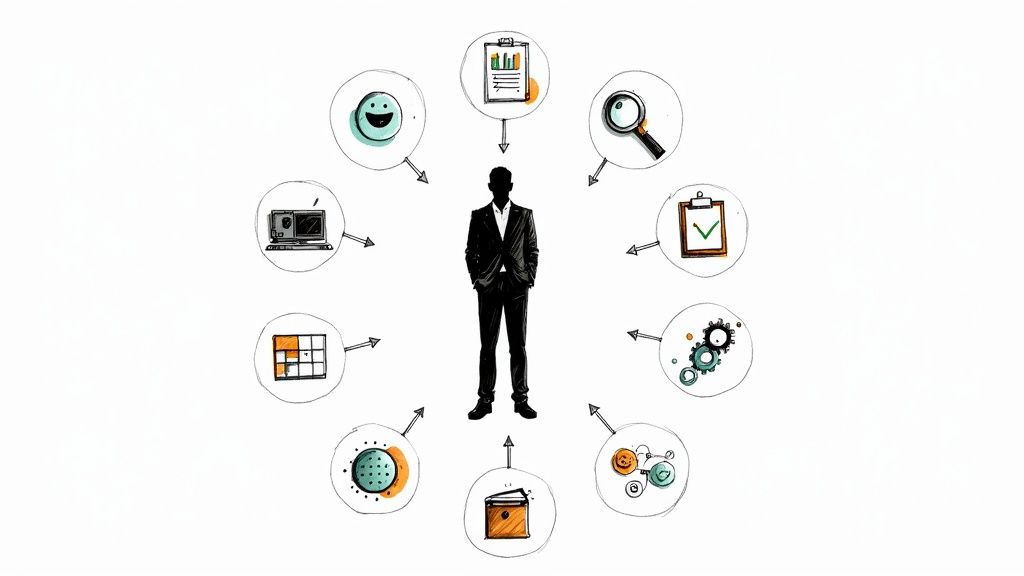Before you can even think about cutting recruitment costs, you have to know exactly where the money is going. It's a common mistake to jump straight to slashing budgets. The real first step is a full-blown audit to uncover every single hiring expense—especially the ones hiding in plain sight. This deep dive is what allows you to make smart, strategic cuts instead of just taking wild guesses.
Pinpointing Your True Recruitment Spend

So many businesses only track the obvious stuff, like fees for job boards or payments to recruiting agencies. But the real story of your spending is often buried in the indirect costs that pile up fast. To get the full picture, you need to calculate your true cost-per-hire. This metric should account for every dollar and every hour that goes into bringing someone new onto the team.
This means you’ve got to look beyond the surface-level numbers. In 2025, the average cost to bring on a new employee is sitting at around $4,700. But for specialized or executive roles? That number can easily blow past $20,000. These figures aren’t just plucked from thin air; they include everything from recruiter fees and HR software subscriptions to the lost productivity while a new hire gets up to speed.
Categorizing Your Hiring Expenses
To kick off your audit, start by grouping your expenses into a few clear buckets. This simple organization immediately shows you which areas are eating up the most of your budget.
Here’s a straightforward breakdown I’ve seen work well:
- Direct Advertising Costs: This is your spend on job postings, whether on big sites like LinkedIn and Indeed or smaller, niche industry boards.
- Technology and Software: Think about your monthly or annual subscriptions. This includes your Applicant Tracking System (ATS), any video interviewing platforms, and other HR tech you rely on.
- Agency and Recruiter Fees: Any money paid to external recruitment firms or freelance headhunters goes here. Simple enough.
- Internal Time and Labor: This is the big one everyone misses. You have to calculate the cost of your team's time. How many salaried hours do your people—from HR specialists to department heads—spend screening resumes, sitting in interviews, and holding debrief meetings?
Key Takeaway: The time your current employees spend on hiring is a significant, real cost. If a manager earning $100,000 per year spends 20 hours on a single hire, that’s nearly $1,000 in salary cost allocated just to that one position.
To illustrate, here's how you might break down the costs for a single hire.
Recruitment Cost Breakdown Example
This table provides a sample breakdown, showing how both direct and indirect expenses contribute to the total cost-per-hire.
| Cost Category | Description | Example Expense |
|---|---|---|
| External Costs | Direct, out-of-pocket expenses paid to third-party vendors. | |
| Advertising Fees | Job board postings on LinkedIn, Indeed, etc. | $400 |
| Recruitment Agency Fee | Percentage-based fee for a successful placement. | $12,000 |
| Technology | Monthly cost of ATS and video interview software. | $150 |
| Screening | Background check and drug screening services. | $100 |
| Internal Costs | Costs related to internal resources and team members' time. | |
| Referral Bonus | Bonus paid to an employee for a successful referral. | $1,500 |
| Interviewer Time | Salaried time for 4 team members (20 hours total). | $960 |
| HR/Recruiter Time | Salaried time for the recruiter managing the process (30 hours). | $1,200 |
| Total Cost-Per-Hire | Sum of all external and internal costs. | $16,310 |
Mapping out your costs this way makes it painfully clear where your budget is actually going.
Uncovering Hidden and Indirect Costs
Once you've got the main categories sorted, it's time to dig for the hidden costs. These are the silent budget-killers that inflate your cost-per-hire without you even noticing.
Think about expenses like:
- Background check services and any required drug screenings.
- Employee referral bonuses that get paid out to your team.
- Lost productivity from having an empty seat and the impact on the team's output.
- Onboarding materials and the costs associated with your training programs.
When you meticulously track both the obvious and the hidden costs, you’re no longer guessing. You're building a complete financial model of your entire hiring machine. This data-driven foundation is the absolute bedrock of any successful cost-reduction plan. And honestly, this mindset extends beyond just hiring; applying proven strategies to reduce operating costs across the business can give you principles that translate directly to a smarter hiring budget. This initial analysis is your roadmap to spending smarter, not just spending less.
Building an Irresistible Employer Brand

One of the most powerful, long-term ways to slash recruitment costs has almost nothing to do with cutting line items from your budget. It’s all about building a reputation so magnetic that top talent comes to you. When your employer brand is strong, it acts as a silent, always-on recruiting engine, drawing in high-quality candidates organically.
This shift dramatically cuts your reliance on expensive job board placements and aggressive (and costly) headhunting. When the best people are actively seeking you out, your cost-per-hire naturally plummets. The real goal here is to become a place where skilled professionals not only want to work but also build a career. That's how you break the expensive cycle of constantly hiring and rehiring.
Showcase Your Authentic Company Culture
Your company culture is your secret weapon. It’s your organization's unique personality, and it’s one of your most valuable assets in the war for talent. But here’s the thing: you can't just talk about it. You have to show it.
Turn your career page, company blog, and social media channels into a window into daily life at your company. Share real stories of team wins, put a spotlight on individual employees (with their permission, of course!), and post behind-the-scenes photos from company outings or even just a typical Tuesday. Authenticity is everything. A polished, corporate-speak description of your "collaborative environment" pales in comparison to a quick, unscripted video of your team geeking out over a project on a whiteboard.
Expert Tip: Kick off an "employee-generated content" initiative. Encourage your team to share their work experiences on platforms like LinkedIn using a unique company hashtag. Their genuine voices carry far more weight and credibility than any official company statement ever could.
Emphasize Growth and Internal Mobility
Let's be honest: today's best talent craves growth and development. A dead-end job is one of the top reasons people walk out the door, forcing you right back into the expensive recruitment hamster wheel. This is why promoting from within isn’t just a nice-to-have; it’s a massive cost-saver. You eliminate external search fees, slash onboarding time, and give company-wide morale a serious boost.
The numbers don't lie. The global talent shortage is projected to leave 85.2 million positions unfilled by 2030, and 69% of companies already say they're struggling to hire. Research also shows a leading reason employees quit is a lack of career growth (49%). When you build clear pathways for advancement, you not only keep your best people but also become a magnet for ambitious external candidates.
To make this a reality, you need a structured internal mobility program.
- Publicize Open Roles Internally: Make it a policy that every new role is posted for current employees to see, either before or at the same time it goes public.
- Create Development Plans: Sit down with your employees. Map out their career goals and then give them the training, mentorship, and opportunities they need to get there.
- Celebrate Internal Promotions: When someone moves up, make a big deal out of it! Share the news widely to reinforce the message that growth isn't just possible at your company—it's encouraged.
A strong employer brand is your foundation for attracting top talent and cutting down on costly recruitment channels. To really get the word out, explore different strategies for building your brand on social media and connect with a much wider audience organically.
Clearly Define and Communicate Your Value Proposition
Your Employee Value Proposition (EVP) is your "why." It's the unique deal you offer employees in exchange for their skills, time, and effort. It goes way beyond salary to cover everything that makes your company a genuinely great place to work.
A good EVP directly answers a candidate's most important question: "What's in it for me?"
Elements of a Strong EVP
| Component | Description | Example |
|---|---|---|
| Compensation | The full scope of financial rewards. | Competitive salary, performance bonuses, stock options. |
| Benefits | Health, wellness, time off, and other perks. | Comprehensive health insurance, mental health support, generous PTO. |
| Career | Opportunities for advancement and development. | Clear promotion paths, mentorship programs, tuition reimbursement. |
| Work Environment | The physical and cultural atmosphere of the workplace. | Flexible work hours, remote-friendly policies, a collaborative team. |
| Company Culture | The core values, mission, and "vibe" of the organization. | A commitment to diversity, social responsibility initiatives, innovation days. |
Once you've nailed down your EVP, weave it into every single touchpoint of the candidate's journey. It should be reflected in your job descriptions, interview questions, and onboarding process. A compelling EVP doesn't just attract more candidates—it attracts the right candidates, which is the ultimate way to save time and money.
Rethink Your Sourcing and Screening Game

Let's be honest. The early stages of hiring—sourcing and screening—can feel like a black hole where time and money just disappear. Every hour your team sinks into sifting through stacks of unqualified resumes is a direct hit to your budget.
When you get your sourcing and screening right, you stop wasting energy on candidates who were never going to be a fit. It’s not about casting the widest net possible. It's about being smarter and more intentional from the very start. The goal is simple: spend your valuable resources only on people with a real shot at succeeding with you.
Turn Your Team into a Recruiting Engine with Referrals
If there’s one tactic that consistently delivers high-quality hires for less money, it’s an employee referral program. Time and again, I’ve seen referred candidates onboard faster, perform better, and stick around longer. It makes perfect sense—your own people are your best filter, recommending individuals they genuinely believe will thrive in your culture.
But just having a referral policy tucked away in a handbook won't cut it. You have to actively champion it.
- Keep It Simple: Submitting a referral should take two minutes, max. If it’s a complicated process, your team won’t bother.
- Make the Reward Worth It: Cash is king, but don't underestimate the power of extra PTO or public shout-outs. For those really tough-to-fill roles, try a tiered bonus to focus your team's efforts where you need them most.
- Don't Stop Talking About It: Keep referrals top of mind. Feature open roles in your all-hands meetings and company newsletters, and always end with a specific ask for recommendations.
Here's the real-world math: Imagine you offer a $1,000 referral bonus for a role that would otherwise cost $8,000 to fill through a third-party recruiter. You instantly save $7,000 and, more often than not, you get a more invested and culturally-aligned hire in the bargain.
Write Job Descriptions That Do the Screening for You
Your job description isn't just a list of duties; it’s your very first screening tool. A generic, copy-pasted description invites a flood of applications from everyone, burying your team. A sharp, well-crafted one, however, attracts the right people and gently tells the wrong ones, "This probably isn't for you."
Think of it less like a chore and more like a targeted marketing campaign.
- Lead with the Mission: Don't just list tasks. Start with the "why." What impact will this person have? This grabs the attention of candidates who are looking for purpose, not just a paycheck.
- Be Brutally Honest About "Must-Haves": Get ruthless about what's truly essential versus what's just "nice to have." A laundry list of 20 requirements will scare away fantastic candidates who check 90% of the important boxes.
- Show, Don't Just Tell: Instead of using clichés like "fast-paced environment," get specific. "You'll be juggling three major product launches in your first six months." This paints a clear picture and lets candidates self-select out if that pace sounds like a nightmare to them.
Go Hunt for Talent (They Aren't All Looking for You)
If you're only looking at people who apply on job boards, you're missing out on a huge pool of top-tier talent. These are your passive candidates—the skilled professionals who are already employed and doing great work, but who would make a move for the right opportunity.
Finding them requires a more proactive, almost surgical approach. LinkedIn is the obvious place to start, but you need to go deeper. Get active in industry-specific Slack communities, "attend" virtual conferences, and keep an eye on X (formerly Twitter) for people sharing insightful work.
A personalized message to someone who isn't even looking is infinitely more powerful than a generic job ad. This lets you focus your energy on a small, curated group of high-potential individuals, which is a surefire way to drive down your hiring costs.
To get more tactical about this part of your funnel, check out our guide on automated candidate screening, which is packed with strategies to help you spot top talent more efficiently.
Using Technology to Boost Hiring Efficiency
Let's be honest: modern technology isn't just a "nice-to-have" in recruiting anymore. It's become absolutely essential for cutting costs and reclaiming precious time. Some of the biggest hidden expenses in any hiring process are the manual, repetitive tasks that eat up your team's day. Technology gives you a direct way to automate that work, freeing up your people to focus on what they do best—connecting with great candidates.
When you bring the right tools into your workflow, you can dramatically shorten your time-to-hire, get much clearer insights into your candidate pool, and ultimately bring down your recruitment expenses. The trick is to choose tech that gives you a clear and measurable return.
This infographic breaks down the typical cost and time investments for in-house versus outsourced recruitment. It really highlights how a few strategic choices can lead to some serious savings.

As you can see, strategic outsourcing, which is almost always powered by efficient tech platforms, can slash both the time and money needed to fill a role.
Embrace AI-Powered Applicant Tracking Systems
Think of an Applicant Tracking System (ATS) as the central nervous system for a modern recruiting operation. But they aren't all created equal. The older systems were basically just digital filing cabinets. Today's AI-powered ATS platforms are in a completely different league.
They can automatically parse resumes, screen for specific keywords and qualifications, and even rank candidates based on how well they align with your job description. This one feature alone can cut the time your recruiters spend on that initial screening by 75% or more. Instead of slogging through hundreds of applications by hand, your team gets a pre-vetted shortlist of the most promising people.
Here’s what that looks like in the real world: Your team gets 200 applications for a key role. Manually sifting through them could easily take a full day of work. An AI-powered ATS? It can serve up a top-20 shortlist in minutes. You’ve just saved hours of labor costs and put your entire hiring timeline on the fast track.
Implement Asynchronous Video Interviews
If there's one thing that grinds a hiring process to a halt, it's scheduling. The endless back-and-forth trying to coordinate times between busy candidates and multiple interviewers is a logistical nightmare. It’s also a massive time sink that costs you countless administrative hours.
Asynchronous video interviews wipe this problem off the map.
Instead of a live call, you simply send candidates a set of pre-recorded questions. They get to record their answers on their own schedule, and your hiring team can review the submissions whenever it’s convenient for them. No more calendar Tetris.
This approach pays off in a few key ways for reducing your hiring costs:
- Scheduling becomes a non-issue: You reclaim all those hours that used to be lost to coordinating calls.
- Screening capacity skyrockets: A recruiter can review dozens of video submissions in the same amount of time it would take to conduct just a handful of live phone screens.
- Collaboration gets way easier: It’s simple to share video responses with multiple stakeholders, which leads to more consistent and fair evaluations without the headache of getting everyone in the same room (or on the same call).
Tech like this allows even small teams to handle a much larger volume of candidates far more efficiently. By shifting that initial screening to an asynchronous format, you save your team's valuable live interaction time for the most qualified, final-stage candidates. If you're looking for more ways to make your process more effective, you might be interested in our guide on how to improve recruiting efficiency.
For a deeper dive into how different technologies stack up, this table provides a clear comparison.
Technology Impact on Recruitment Costs
This table compares traditional recruitment methods with technology-assisted approaches, highlighting the direct impact on cost and time.
| Recruitment Task | Traditional Method (Cost/Time) | Technology-Assisted Method (Cost/Time) | Potential Savings |
|---|---|---|---|
| Initial Screening | 5-10 hours of manual resume review | 1-2 hours with an AI-powered ATS | 80% time reduction |
| First-Round Interviews | 8-12 hours for phone screens | 2-3 hours reviewing async videos | 75% time reduction |
| Scheduling | 3-5 hours of admin coordination | <1 hour with automated scheduling | 80%+ time reduction |
| Candidate Sourcing | High cost of job boards, agencies | Lower cost via social media, referrals | 30-50% cost reduction |
The numbers don't lie. Integrating technology isn't just about modernizing; it's a direct strategy for making your hiring process leaner and more effective.
To really tackle manual work and boost your speed, investing in specialized Recruitment Automation Tools is a game-changer. When you combine the right ATS with a video interviewing platform, you create a powerful, cost-effective tech stack that directly attacks the most expensive and time-consuming parts of the hiring process.
Fine-Tuning Your Interview and Offer Game
This is where the magic happens—or where it all falls apart. The final stretch of the hiring funnel is a minefield of missed opportunities. A disorganized, inconsistent interview process doesn't just leave a bad taste in candidates' mouths; it directly punches a hole in your budget. When your top pick drops out at the eleventh hour, you're right back at square one, doubling the time and money you've already sunk into the role.
Polishing your interview and offer process isn’t about being cheap. It’s about being deliberate. The idea is to move away from those gut-feel, "winging it" conversations and toward a solid framework that actually predicts who will succeed, boosts your offer acceptance rate, and, most importantly, slashes your cost-per-hire.
Turn Your Managers into Interviewing Pros
Let's be honest: your hiring managers are on the front lines, but most were promoted into their roles without a lick of formal interview training. This leads to a wild west of evaluation styles, biased questions, and an experience that feels completely different for every candidate. That inconsistency is a massive liability and a huge source of wasted time.
The answer is simple: structured interviews. This just means every candidate for a given role gets asked the same core set of questions. It shifts the entire dynamic from a casual chat to a standardized assessment of real skills, making the whole thing far more objective and reliable.
Here’s how to get your managers up to speed:
- Hand them an interview kit. For each role, build a simple package with the key questions, a scoring guide, and a no-nonsense overview of the absolute "must-have" qualifications.
- Train them on behavioral questions. You know the ones: "Tell me about a time when…" These are powerful because they force candidates to give real-world proof of their skills, not just talk a big game.
- Create a "do-not-ask" list. Give them clear guardrails on what to avoid to sidestep legal trouble and unconscious bias. This ensures a fair and compliant process for everyone.
By standardizing the interview, you're not just being fair—you're building a repeatable, data-driven system. It makes comparing candidates an apples-to-apples affair and dramatically cuts the risk of making a bad hire you'll have to replace in six months. And that? That's one of the biggest hidden costs in recruiting.
Negotiate Offers with Data, Not Drama
The offer stage can feel like a high-stakes poker game. Go in too high, and you're inflating your salary budget for no reason. Lowball them, and your first choice walks, sending you right back to the drawing board. Smart negotiation isn't about winning a battle; it's about finding that sweet spot where everyone feels good about the outcome.
The key is to arm your team with data. Before you even think about picking up the phone, do your homework on salary benchmarks. Knowing the real market rate for a role in your city and industry gives you a solid, logical starting point. It immediately changes the tone from an emotional tug-of-war to a sensible discussion based on facts.
And when you make the offer, think bigger than just the base salary. You need to sell the total compensation package. Remind candidates of all the value you're bringing to the table:
- The Extras: Don't forget to mention bonuses, stock options, or profit-sharing plans.
- Health & Wellness: Talk up your killer insurance plans, mental health support, or wellness stipends.
- Career Growth: Do you have a budget for professional development, training, or tuition? Shout it from the rooftops.
- Work-Life Balance: Generous PTO, flexible hours, and remote work options are hugely valuable. Put a number on it if you can.
Think about it this way: a candidate might be fixated on a base salary that’s $5,000 higher at another company. But if you can clearly lay out how your comprehensive benefits package is worth $8,000 more, you completely reframe the conversation. This strategic approach helps you land top talent without torpedoing your budget, directly lowering your recruitment spend one smart offer at a time.
Use Data to Sharpen Your Strategy
You can't fix what you can't see. If you really want to lower your hiring costs for good, you have to stop treating recruitment as a series of one-off projects. Instead, think of it as a continuous cycle of improvement—one that’s fueled by data. When you start measuring the right things, the path to a leaner, more effective hiring process becomes surprisingly clear.
This shift in mindset moves you from guessing to knowing. No more slashing budgets blindly and hoping for the best. You'll be making surgical adjustments based on hard evidence, building a recruitment engine that not only finds fantastic talent but also gets more efficient with every single hire.
Identify and Track Your Key Metrics
First things first, you need to focus on a handful of crucial recruitment metrics. Think of these as the vital signs of your hiring health. Don't overcomplicate it. Just start with the essentials that give you the biggest bang for your buck in terms of insight.
- Cost-Per-Hire: We've already touched on this one, but it’s the absolute cornerstone. Tracking it over time is the only way to know if your cost-saving efforts are actually paying off.
- Time-to-Fill: How many days pass between posting a job and getting an offer accepted? A long time-to-fill isn't just frustrating; it means lost productivity and ballooning internal labor costs.
- Source-of-Hire: Where are your best candidates really coming from? Job boards? Referrals? Social media? Knowing this is the key to spending your budget where it counts.
- Quality-of-Hire: This is the ultimate metric, the one that tells you if all the effort was worth it. It’s a measure of how well a new employee is doing after they're settled in, often gauged by their first performance review.
Tracking these numbers gives you a solid baseline. It turns those vague feelings about your hiring process into concrete data you can actually use.
Turn Your Data into Action
Collecting data is just the start. The real magic happens when you use it to make smarter decisions. By connecting the dots between these different metrics, you’ll uncover your biggest opportunities to trim your recruitment costs.
For example, let's say you dig into your source-of-hire data. You might find that a niche job board is pricey, but it consistently delivers candidates who turn into top performers (a high quality-of-hire). On the flip side, that cheap, high-volume job board might flood you with applicants, but almost none of them make it past the first screening, wasting your team's valuable time.
Key Takeaway: By analyzing your source data, you can confidently double down on high-ROI channels and slash spending on the ones that just drain your budget. This strategic reallocation is what continuous improvement is all about.
This process of analyzing and adjusting needs to be a regular habit. A great first step is to lay out your entire workflow to spot these data-driven opportunities. If you're interested in going deeper, you can learn about the benefits of recruitment process mapping and how it shines a light on hidden inefficiencies. A data-driven strategy isn't something you set and forget; it adapts as your company grows and the talent market shifts, ensuring your recruitment spend is always working as hard as you do.
Burning Questions About Cutting Recruitment Costs
It’s only natural to have questions when you're trying to get a handle on hiring expenses. Let's tackle some of the most common ones that come up when businesses decide to get serious about their recruitment budget.
What’s a Good Cost-Per-Hire to Aim For?
If you're looking for a single magic number, you won't find one. The ideal cost-per-hire really swings depending on your industry, the seniority of the role, and even where you're located. A decent benchmark to start with is the industry average, which often hovers between $4,000 and $5,000 for most non-executive positions.
But honestly, the best goal is always a personal one. The first step is to figure out what you're currently spending. Once you have that number, set a realistic target to shrink it, maybe by 15-20%, over the next twelve months. You can get there by implementing some of the strategies we've discussed, like building out a great employee referral program or adopting smarter tech.
How Can Small Businesses Cut Back on Hiring Costs?
For small businesses, the key is to focus on high-impact tactics that don't break the bank. It's about being scrappy and smart.
Building a solid employer brand on social media, for instance, costs more in time than it does in cash, and it's a fantastic way to pull in organic applicants who are already interested in what you're doing.
An effective employee referral program is another game-changer. Offering a modest bonus for a successful hire is almost always cheaper than paying for job board advertisements or agency fees.
Finally, don't overlook free or low-cost tools. Asynchronous video interviewing platforms can completely wipe out the hours of administrative back-and-forth spent just trying to schedule initial phone screens.
Does Promoting Internally Really Save That Much Money?
Oh, absolutely. Promoting from within is hands-down one of the most effective ways to slash your recruitment costs. Right off the bat, you eliminate all your external advertising spend and any potential agency fees.
But the real savings are in the hidden costs. An internal hire already gets your company culture, knows the internal processes, and understands the team dynamics. That means their onboarding time is drastically shorter and way less expensive. They hit full productivity much faster and, more often than not, stick around for the long haul.
Ready to slash your screening time and hiring costs? Async Interview automates your initial interviews, letting you identify top talent up to 10x faster. Discover how our platform can transform your recruitment process today.




